formerly eScholarship Editions


|
|
|
|
Your request for similar items found 20 book(s). | Modify Search | Displaying 1 - 20 of 20 book(s) | |
| 1. | 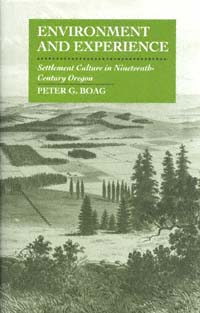 | Title: Environment and experience: settlement culture in nineteenth-century Oregon Author: Boag, Peter G Published: University of California Press, 1992 Subjects: History | United States History | Californian and Western History | Environmental Studies Publisher's Description: The pioneer battling with a hostile environment - whether it be arid land, drought, dust storms, dense forests, or harsh winters - is a staple of western American history. In this innovative, multi-disciplinary work, Peter Boag takes issue with the image of the settler against the frontier, arguing that settlers viewed their new surroundings positively and attempted to create communities in harmony with the landscape. Using Oregon's Calapooia Valley as a case study, Boag presents a history of both land and people that shows the process of change as settlers populated the land and turned it to their own uses.By combining local sources, ranging from letters and diaries to early maps and local histories, and drawing upon the methods of geography, natural history, and literary analysis, Boag has created a richly detailed grass-roots portrait of a frontier community. Most significantly, he analyzes the connections among environmental, cultural, and social changes in ways that illuminate the frontier experience throughout the American west. [brief] Similar Items |
| 2. | 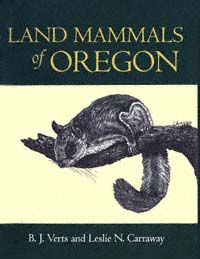 | Title: Land mammals of Oregon Author: Verts, B. J Published: University of California Press, 1998 Subjects: Science | Zoology | Biology | Natural History Publisher's Description: This is the first comprehensive, up-to-date treatment of mammals in the state of Oregon since 1936, when Vernon Bailey's The Mammals and Life Zones of Oregon was published. It provides a basic reference for mammalogists, wildlife biologists, students, and anyone interested in mammalian life in the northwestern United States. Indeed, researchers in states adjacent to Oregon will find much useful information regarding the mammals their regions share with Oregon. Descriptions of all 136 extant or recently extirpated mammal species in Oregon are in the book, with information on geographical variation, diet, reproduction, ontogeny, mortality, and behavior. The authors provide range maps and lists of collection localities based on their examination of 55,265 museum specimens and brief accounts of morphology, species diversity, distribution, and fossil records. Keys to orders, families, and species are provided for identification of unknown specimens. Also helpful is the introductory section with its discussion of skull morphology, evolutionary history, basic taxonomy, zoogeography, zoonotic diseases, and the history of mammalogy in Oregon. A bibliography of 2,925 references makes the volume especially useful for anyone wishing to do further research. [brief] Similar Items |
| 3. | 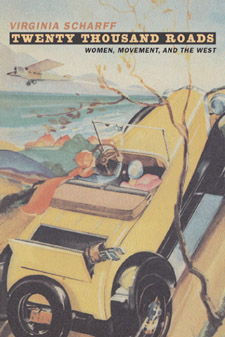 | Title: Twenty thousand roads: women, movement, and the West Author: Scharff, Virginia Published: University of California Press, 2002 Subjects: History | Women's Studies | California and the West Publisher's Description: From Sacagawea's travels with Lewis and Clark to rock groupie Pamela Des Barres's California trips, women have moved across the American West with profound consequences for the people and places they encounter. Virginia Scharff revisits a grand theme of United States history - our restless, relentless westward movement--but sets out in new directions, following women's trails from the early nineteenth to the late twentieth centuries. In colorful, spirited stories, she weaves a lyrical reconsideration of the processes that created, gave meaning to, and ultimately shattered the West. Twenty Thousand Roads introduces a cast of women mapping the world on their own terms, often crossing political and cultural boundaries defined by male-dominated institutions and perceptions. Scharff examines the faint traces left by Sacagawea and revisits Susan Magoffin's famed honeymoon journey down the Santa Fe Trail. We also meet educated women like historian Grace Hebard and government extension agent Fabiola Cabeza de Baca, who mapped the West with different voyages and visions. Scharff introduces women whose lives gave shape to the forces of gender, race, region, and modernity; participants in exploration, war, politics, empire, and struggles for social justice; and movers and shakers of everyday family life. This book powerfully and poetically shows us that to understand the American West, we must examine the lives of women who both built and resisted American expansion. Scharff remaps western history as she reveals how moving women have shaped our past, present, and future. [brief] Similar Items |
| 4. | 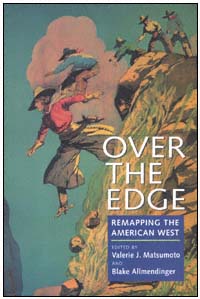 | Title: Over the edge: remapping the American West Author: Matsumoto, Valerie J Published: University of California Press, 1999 Subjects: American Studies | California and the West | Popular Culture | History | United States History | Californian and Western History | German Studies Publisher's Description: From the Gold Rush to rush hour, the history of the American West is fraught with diverse, subversive, and at times downright eccentric elements. This provocative volume challenges traditional readings of western history and literature, and redraws the boundaries of the American West with absorbing essays ranging widely on topics from tourism to immigration, from environmental battles to interethnic relations, and from law to film. Taken together, the essays reassess the contributions of a diverse and multicultural America to the West, as they link western issues to global frontiers.Featuring the latest work by some of the best new writers both inside and outside academia, the original essays in Over the Edge confront the traditional field of western American studies with a series of radical, speculative, and sometimes outrageous challenges. The collection reads the West through Ben-Hur and the films of Mae West; revises the western American literary canon to include the works of African American and Mexican American writers; examines the implications of miscegenation law and American Indian blood quantum requirements; and brings attention to the historical participation of Mexican and Japanese American women, Native American slaves, and Alaskan cannery workers in community life. [brief] Similar Items |
| 5. | 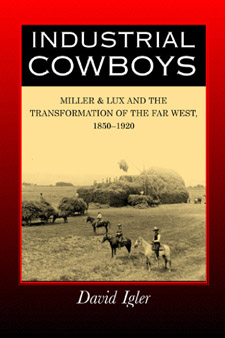 | Title: Industrial cowboys: Miller & Lux and the transformation of the Far West, 1850-1920 Author: Igler, David 1964- Published: University of California Press, 2001 Subjects: History | United States History | Californian and Western History | Environmental Studies | California and the West | Agriculture | Economics and Business Publisher's Description: Few industrial enterprises left a more enduring imprint on the American West than Miller & Lux, a vast meatpacking conglomerate started by two San Francisco butchers in 1858. Industrial Cowboys examines how Henry Miller and Charles Lux, two German immigrants, consolidated the West's most extensive land and water rights, swayed legislatures and courts, monopolized western beef markets, and imposed their corporate will on California's natural environment. Told with clarity and originality, this story uses one fascinating case study to illuminate the industrial development and environmental transformation of the American West during the late nineteenth and early twentieth centuries. The process by which two neighborhood butchers turned themselves into landed industrialists depended to an extraordinary degree on the acquisition, manipulation, and exploitation of natural resources. David Igler examines the broader impact that industrialism--as exemplified by Miller & Lux--had on landscapes and waterscapes, and on human as well as plant and animal life in the West. He also provides a rich discussion of the social relations engineered by Miller & Lux, from the dispossession of Californio rancheros to the ethnic segmentation of the firm's massive labor force. The book also covers such topics as land acquisition and reclamation, water politics, San Francisco's unique business environment, and the city's relation to its surrounding hinterlands. Above all, Igler highlights essential issues that resonate for us today: who holds the right and who has the power to engineer the landscape for market production? [brief] Similar Items |
| 6. |  | Title: Protecting motherhood: Women and the family in the politics of postwar West Germany Author: Moeller, Robert G Published: University of California Press, 1993 Subjects: History | European History | Women's Studies | German Studies Publisher's Description: Robert G. Moeller is the first historian of modern German women to use social policy as a lens to focus on society's conceptions of gender difference and "woman's place." He investigates the social, economic, and political status of women in West Germany after World War II to reveal how the West Germans, emerging from the rubble of the Third Reich, viewed a reconsideration of gender relations as an essential part of social reconstruction.The debate over "woman's place" in the fifties was part of West Germany's confrontation with the ideological legacy of National Socialism. At the same time, the presence of the Cold War influenced all debates about women and the family. In response to the "woman question," West Germans defined the boundaries not only between women and men, but also between East and West.Moeller's study shows that public policy is a crucial arena where women's needs, capacities, and possibilities are discussed, identified, defined, and reinforced. Nowhere more explicitly than in the first decade of West Germany's history did, in Joan Scott's words, "politics construct gender and gender construct politics." [brief] Similar Items |
| 7. |  | Title: Rugged justice: the Ninth Circuit Court of Appeals and the American West, 1891-1941 Author: Frederick, David C Published: University of California Press, 1994 Subjects: History | History | United States History | Californian and Western History | California and the West | Law Publisher's Description: Few chapters in American judicial history have enjoyed as colorful a past as has the U.S. Court of Appeals for the Ninth Circuit. Created in 1891, its jurisdiction now encompasses California, Oregon, Nevada, Washington, Idaho, Montana, Arizona, Hawaii, and Alaska. David Frederick has mined archival sources, including court records and legal papers throughout the West and in Washington, D.C., to document the Ninth Circuit's first fifty years. His findings are much more than a record of the court, however, for they also provide a unique social and cultural history of the West.During these years, the court heard key cases involving railroads, the Alaska gold rush, Chinese immigration, organized labor, and use of natural resources. Many of the decisions from this period foreshadowed issues that are with us today. Frederick also documents the court's part in Western development and in issues relating to World War I, Prohibition, New Deal legislation, and the evolving role of federal judges.Frederick portrays the West's most important judicial institution with clarity and intelligence, reminding us that the evolution of the Ninth Circuit both reflected and affected the dramatic changes occurring in the West during the court's early years. This is a book that will appeal not only to lawyers, but to historians, sociologists, and general readers as well. [brief] Similar Items |
| 8. | 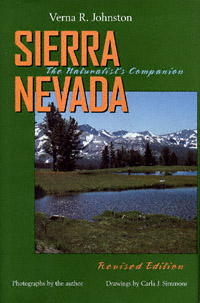 | Title: Sierra Nevada: the naturalist's companion Author: Johnston, Verna R Published: University of California Press, 1998 Subjects: Environmental Studies | Environmental Studies | California and the West Publisher's Description: All lovers of the mountains will welcome Verna Johnston's new and completely updated edition of her classic, Sierra Nevada , originally published in 1970. A professional biologist, veteran ornithologist, and well-known wildlife photographer, Johnston is the perfect guide for a natural-history trip into the Sierra. Regardless of how one explores the magnificent 400-mile-long mountain range, on foot or by car, in an armchair or a classroom, this is the book to have.Beginning with the western foothills, Johnston evokes a vivid picture of the varied plant and animal life encountered as the elevation increases, tops the crest, and drops to the more precipitous, arid eastern Sierra slope. The reader is taken through chaparral and mountain meadows, pine and fir forests, granite expanses and snowy peaks. Johnston writes of the Native Americans' uses and stewardship of the land, the role of fire in forest ecology, the eras of sheep herders and loggers, the work of John Muir and other preservationists, and the battles to save Mono Lake and Lake Tahoe. Her lifetime of field experience and discovery offers intimate observations of rarely recorded events: the courtship of the Sierra Nevada salamander, a wolverine attacking two bears, a fight to the death between a skink and a scorpion.Many changes have occurred in the Sierra since the first edition of this book was published, including acid snow, tensions involving human and cougar habitats, and an ominous drop in amphibian populations. Johnston documents these events and updates the ecological research in the rich, evocative writing style that makes her book a naturalist's treasure. This is a guide to the Sierra Nevada for the next millennium. [brief] Similar Items |
| 9. | 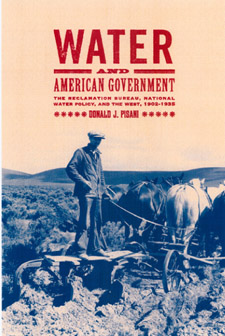 | Title: Water and American government: the Reclamation Bureau, national water policy, and the West, 1902-1935 Author: Pisani, Donald J Published: University of California Press, 2002 Subjects: History | United States History | Water | Public Policy | Geography | California and the West | Californian and Western History Publisher's Description: Donald Pisani's history of perhaps the boldest economic and social program ever undertaken in the United States--to reclaim and cultivate vast areas of previously unusable land across the country - shows in fascinating detail how ambitious government programs fall prey to the power of local interest groups and the federal system of governance itself. What began as the underwriting of a variety of projects to create family farms and farming communities had become by the 1930s a massive public works and regional development program, with an emphasis on the urban as much as on the rural West. [brief] Similar Items |
| 10. | 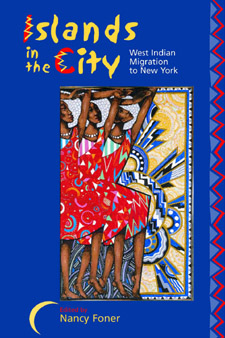 | Title: Islands in the city: West Indian migration to New York Author: Foner, Nancy 1945- Published: University of California Press, 2001 Subjects: Anthropology | Ethnic Studies | Cultural Anthropology | Social Problems Publisher's Description: This collection of original essays draws on a variety of theoretical perspectives, methodologies, and empirical data to explore the effects of West Indian migration and to develop analytic frameworks to examine it. Similar Items |
| 11. | 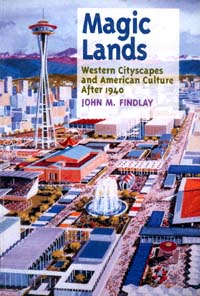 | Title: Magic lands: western cityscapes and American culture after 1940 Author: Findlay, John M 1955- Published: University of California Press, 1992 Subjects: History | United States History | California and the West | American Studies | Urban Studies | Californian and Western History Publisher's Description: The American West conjures up images of pastoral tranquility and wide open spaces, but by 1970 the Far West was the most urbanized section of the country. Exploring four intriguing cityscapes - Disneyland, Stanford Industrial Park, Sun City, and the 1962 Seattle World's Fair - John Findlay shows how each created a sense of cohesion and sustained people's belief in their superior urban environment. This first book-length study of the urban West after 1940 argues that Westerners deliberately tried to build cities that differed radically from their eastern counterparts.In 1954, Walt Disney began building the world's first theme park, using Hollywood's movie-making techniques. The creators of Stanford Industrial Park were more hesitant in their approach to a conceptually organized environment, but by the mid-1960s the Park was the nation's prototypical "research park" and the intellectual downtown for the high-technology region that became Silicon Valley.In 1960, on the outskirts of Phoenix, Del E. Webb built Sun City, the largest, most influential retirement community in the United States. Another innovative cityscape arose from the 1962 Seattle World's Fair and provided a futuristic, somewhat fanciful vision of modern life.These four became "magic lands" that provided an antidote to the apparent chaos of their respective urban milieus. Exemplars of a new lifestyle, they are landmarks on the changing cultural landscape of postwar America. [brief] Similar Items |
| 12. | 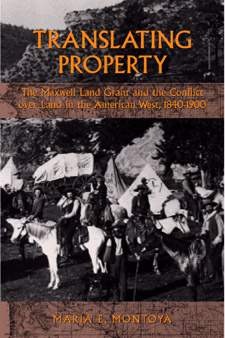 | Title: Translating property: the Maxwell Land Grant and the conflict over land in the American West, 1840-1900 Author: Montoya, María E 1964- Published: University of California Press, 2002 Subjects: History | Californian and Western History | Law | Latino Studies | California and the West | California and the West Publisher's Description: Although Mexico lost its northern territories to the United States in 1848, battles over property rights and ownership have remained intense. This turbulent, vividly narrated story of the Maxwell Land Grant, a single tract of 1.7 million acres in northeastern New Mexico, shows how contending groups reinterpret the meaning of property to uphold their conflicting claims to land. The Southwest has been and continues to be the scene of a collision between land regimes with radically different cultural conceptions of the land's purpose. We meet Jicarilla Apaches, whose identity is rooted in a sense of place; Mexican governors and hacienda patrons seeking status as New World feudal magnates; "rings" of greedy territorial politicians on the make; women finding their own way in a man's world; Anglo homesteaders looking for a place to settle in the American West; and Dutch investors in search of gargantuan returns on their capital. The European and American newcomers all "mistranslated" the prior property regimes into new rules, to their own advantage and the disadvantage of those who had lived on the land before them. Their efforts to control the Maxwell Land Grant by wrapping it in their own particular myths of law and custom inevitably led to conflict and even violence as cultures and legal regimes clashed. [brief] Similar Items |
| 13. | 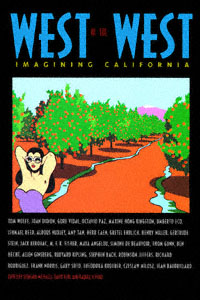 | Title: West of the West: imagining California: an anthology Author: Michaels, Leonard 1933- Published: University of California Press, 1995 Subjects: Literature | Californian and Western History | American Literature | Cultural Anthropology Publisher's Description: Conceived as a novelistic journey through the worlds of California, West of the West offers a vivid and diverse collection of writings on the state where extremes of every sort are dramatically evident in the weather, geography, and people. This richly fascinating collection represents the experience of California both physical and metaphysical, in fiction, poetry, essays, travel writing, confessions, reportage, and social criticism. The authors are native Californians, born-again Californians, exiles, émigrés, critics, and visitors of every kind - Jack Kerouac, Joan Didion, Amy Tan, Simone de Beauvoir, Carey McWilliams, Tom Wolfe, Gore Vidal, Octavio Paz, Jean Baudrillard, Ishmael Reed, Allen Ginsberg - to name just a few. [brief] Similar Items |
| 14. | 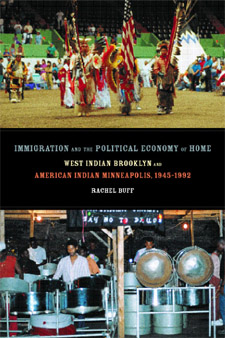 | Title: Immigration and the political economy of home: West Indian Brooklyn and American Indian Minneapolis, 1945-1992 Author: Buff, Rachel 1961- Published: University of California Press, 2001 Subjects: Ethnic Studies | American Studies | Native American Studies | Native American Ethnicity | United States History Publisher's Description: Rachel Buff's innovative study of festivals in two American communities launches a substantive inquiry into the nature of citizenship, race, and social power. Drawing on ethnographic fieldwork as well as archival research, Buff compares American Indian powwows in Minneapolis with the West Indian American Day Carnival in New York. She demonstrates the historical, theoretical, and cultural links between two groups who are rarely thought of together and in so doing illuminates our understanding of the meaning of home and citizenship in the post-World War II period. The book also follows the history of federal Indian and immigration policy in this period, tracing the ways that migrant and immigrant identities are created by both national boundaries and transnational cultural memory. In addition to offering fascinating discussions of these lively and colorful festivals, Buff shows that their importance is not just as a form of performance or entertainment, but also as crucial sites for making and remaking meanings about group history and survival. Cultural performances for both groups contain a history of resistance to colonial oppression, but they also change and creatively respond to the experiences of migration and the forces of the global mass-culture industry. Accessible and engaging, Immigration and the Political Economy of Home addresses crucial contemporary issues. Powwow culture and carnival culture emerge as vital, dynamic sites that are central not only to the formation of American Indian and West Indian identities, but also to the understanding modern America itself: the history of its institution of citizenship, its postwar cities, and the nature of metropolitan culture. [brief] Similar Items |
| 15. | 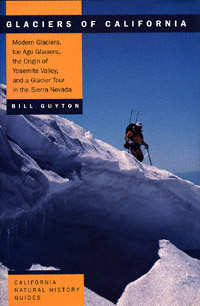 | Title: Glaciers of California: modern glaciers, ice age glaciers, origin of Yosemite Valley, and a glacier tour in the Sierra Nevada Author: Guyton, Bill 1932- Published: University of California Press, 1998 Subjects: Science | Geology | Natural History | California and the West | Geography Publisher's Description: Glaciers in sunny California? Many people will be surprised to learn that there are several hundred in this state, ranging in size from the impressive Whitney Glacier on Mt. Shasta and the Palisade Glacier in the Sierra Nevada to tiny glacierets. While California's glaciers are small compared to those in the northern Rockies or the European Alps, each one is interesting and some are suitable for exploring. Also of note is the fact that Ice Age glaciers carved California's most spectacular mountain scenery - the High Sierra was glaciated several times and glacial landforms are prominent features of the Sierran landscape today.Bill Guyton summarizes the history of the discovery of Ice Age glaciation and modern-day glaciers in California, as well as the development of modern ideas about the state's glacial history. He describes the controversy about the origin of Yosemite Valley and quotes from the colorful accounts of early mountain explorers such as John Muir, Josiah Whitney, and François Matthes. His book provides a primer on glaciers and glacial landforms, a glossary of technical terms, helpful illustrations, and a 100-mile Sierra field trip guide for readers who want to see glaciers and glacial features for themselves. Glaciers of California will make any visit to the mountains more interesting, whether one is carrying a camera, crampons, or a fishing pole. [brief] Similar Items |
| 16. | 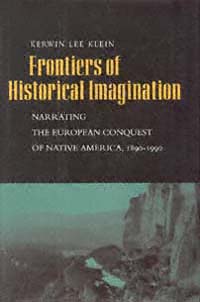 | Title: Frontiers of historical imagination: narrating the European conquest of native America, 1890-1990 Author: Klein, Kerwin Lee 1961- Published: University of California Press, 1997 Subjects: History | California and the West | American Studies | Anthropology | United States History | Intellectual History | Postcolonial Studies Publisher's Description: The American frontier, a potent symbol since Europeans first stepped ashore on North America, serves as the touchstone for Kerwin Klein's analysis of the narrating of history. Klein explores the traditions through which historians, philosophers, anthropologists, and literary critics have understood the story of America's origin and the way those understandings have shaped and been shaped by changing conceptions of history. The American West was once the frontier space where migrating Europe collided with Native America, where the historical civilizations of the Old World met the nonhistorical wilds of the New. It was not only the cultural combat zone where American democracy was forged but also the ragged edge of History itself, where historical and nonhistorical defied and defined each other. Klein maintains that the idea of a collision between people with and without history still dominates public memory. But the collision, he believes, resounds even more powerfully in the historical imagination, which creates conflicts between narration and knowledge and carries them into the language used to describe the American frontier. In Klein's words, "We remain obscurely entangled in philosophies of history we no longer profess, and the very idea of 'America' balances on history's shifting frontiers." [brief] Similar Items |
| 17. | 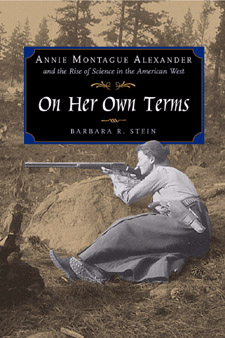 | Title: On her own terms: Annie Montague Alexander and the rise of science in the American West Author: Stein, Barbara R 1955- Published: University of California Press, 2001 Subjects: Autobiographies and Biographies | History of Science | Paleontology | California and the West | Women's Studies Publisher's Description: At a time when women could not vote and very few were involved in the world outside the home, Annie Montague Alexander (1867-1950) was an intrepid explorer, amateur naturalist, skilled markswoman, philanthropist, farmer, and founder and patron of two natural history museums at the University of California, Berkeley. Barbara R. Stein presents a luminous portrait of this remarkable woman, a pioneer who helped shape the world of science in California, yet whose name has been little known until now. Alexander's father founded a Hawaiian sugar empire, and his great wealth afforded his adventurous daughter the opportunity to pursue her many interests. Stein portrays Alexander as a complex, intelligent, woman who--despite her frail appearance--was determined to achieve something with her life. Along with Louise Kellogg, her partner of forty years, Alexander collected thousands of animal, plant, and fossil specimens throughout western North America. Their collections serve as an invaluable record of the flora and fauna that were beginning to disappear as the West succumbed to spiraling population growth, urbanization, and agricultural development. Today at least seventeen taxa are named for Alexander, and several others honor Kellogg, who continued to make field trips after Alexander's death. Alexander's dealings with scientists and her encouragement--and funding--of women to do field research earned her much admiration, even from those with whom she clashed. Stein's extensive use of archival material, including excerpts from correspondence and diaries, allows us to see Annie Alexander as a keen observer of human nature who loved women and believed in their capabilities. Her legacy endures in the fields of zoology and paleontology and also in the lives of women who seek to follow their own star to the fullest degree possible. [brief] Similar Items |
| 18. | 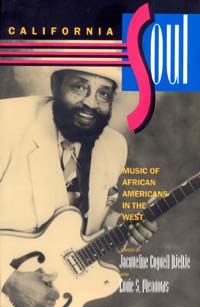 | Title: California soul: music of African Americans in the West Author: DjeDje, Jacqueline Cogdell Published: University of California Press, 1998 Subjects: Music | African American Studies | American Studies | California and the West | Californian and Western History | United States History | Contemporary Music | Jazz Publisher's Description: This new series, co-sponsored with The Center for Black Music Research of Columbia College, seeks to increase our understanding of black music genres and their importance to the cultures of the Atlantic world, including their influence on African musical styles. Books in the series will examine the wide-ranging music of the African diaspora - including the folk-derived musical styles of the Americas as well as European-influenced concert hall music of the entire black Atlantic world - by analyzing issues critical to our interpretation of the music itself and exploring the relationships between music and the other black expressive arts.Focusing on blues, jazz, gospel, rhythm and blues, and soul music, California Soul is one of the first books to explore the rich musical heritage of African Americans in California. The contributors describe in detail the individual artists, locales, groups, musical styles, and regional qualities, and the result is an important book that lays the groundwork for a whole new field of study. The essays draw from oral histories, music recordings, newspaper articles and advertisements, as well as population statistics to provide insightful discussions of topics like the California urban milieu's influence on gospel music, the development of the West Coast blues style, and the significance of Los Angeles's Central Avenue in the early days of jazz. Other essays offer perspectives on how individual musicians have been shaped by their African American heritage, and on the role of the record industry and radio in the making of music. In addition to the diverse range of essays, the book includes the most comprehensive bibliography now available on African American music and culture in California. [brief] Similar Items |
| 19. | 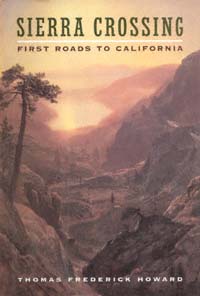 | Title: Sierra crossing: first roads to California Author: Howard, Thomas Frederick 1946- Published: University of California Press, 1998 Subjects: California and the West | Californian and Western History | Geography | United States History Publisher's Description: A critical era in California's history and development - the building of the first roads over the Sierra Nevada - is thoroughly and colorfully documented in Thomas Howard's fascinating book. During California's first two decades of statehood (1850-1870), the state was separated from the east coast by a sea journey of at least six weeks. Although Californians expected to be connected with the other states by railroad soon after the 1849 Gold Rush, almost twenty years elapsed before this occurred. Meanwhile, various overland road ventures were launched by "emigrants," former gold miners, state government officials, the War Department, the Interior Department, local politicians, town businessmen, stagecoach operators, and other entrepreneurs whose alliances with one another were constantly shifting. The broad landscape of international affairs is also a part of Howard's story.Constructing roads and accumulating geographic information in the Sierra Nevada reflected Washington's interest in securing the vast western territories formerly held by others. In a remarkably short time the Sierra was transformed by vigorous exploration, road-promotion, and road-building. Ox-drawn wagons gave way to stagecoaches able to provide service as fine as any in the country. Howard effectively uses diaries, letters, newspaper stories, and official reports to recreate the human struggle and excitement involved in building the first trans-Sierra roads. Some of those roads have become modern highways used by thousands every day, while others are now only dim traces in the lonely backcountry. [brief] Similar Items |
| 20. |  | Title: Conquests and historical identities in California, 1769-1936 Author: Haas, Lisbeth Published: University of California Press, 1995 Subjects: History | Californian and Western History | Ethnic Studies | Latino Studies | American Studies | Gender Studies | California and the West | United States History Publisher's Description: Spanning the period between Spanish colonization and the early twentieth century, this well-argued and convincing study examines the histories of Spanish and American conquests, and of ethnicity, race, and community in southern California. Lisbeth Haas draws on a diverse body of source materials (mission and court archives, oral histories, Spanish language plays, census and tax records) to build a new picture of rural society and social change.A borderlands and Chicano history, Haas's work provides a richly textured study of events that took place in and around San Juan Capistrano and Santa Ana in present-day Orange County. She provides a vivid sense of how and why the past acquires meaning in the lives that make up the historical identities she discusses. The voices of Juaneño and Luiseño Indians, Californios, and Mexicans are heard along the shifting faultlines of economic, social, and political change.This is one of the first truly multiethnic histories of California and of the West. It makes clear that issues of multiculturalism and ethnicity are not recent manifestations in California - they have characterized social and cultural relationships there since the late eighteenth century. [brief] Similar Items |